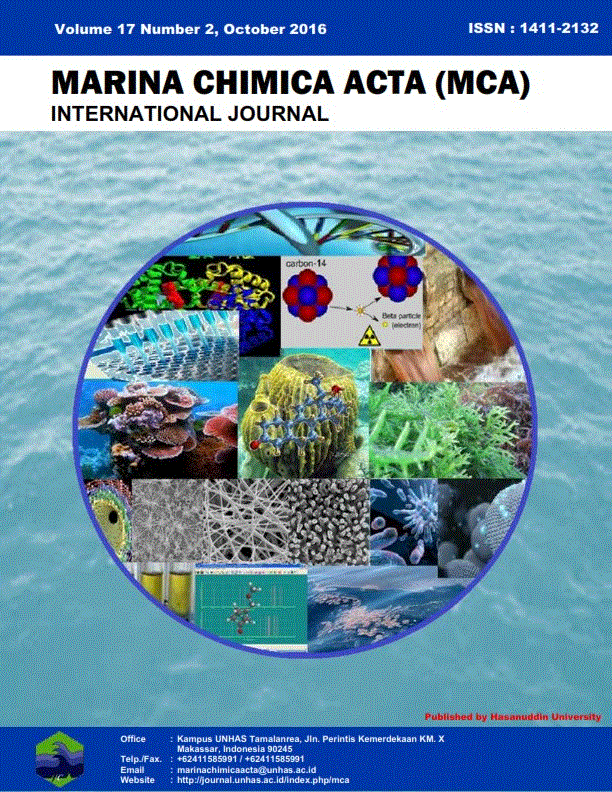ISOLATION, IDENTIFICATION AND BIOACTIVITY TEST OF NON POLAR COMPOUNDS ON n-HEXANE EXTRACT OF Haliclona (Reniera) fascigera FROM SAMALONA ISLAND-SPERMONDE ARCHIPELAGO
Abstract
Isolation, identification and bioactivity test of nonpolar compunds has been conducted on n-hexane extract sponge Haliclona (Reniera) fascigera of the island Samalona, Makassar, South Sulawesi. Isolation techniques consist of maceration, partition, fractionation using 2 steps using vacuum column chromatography and flash column chromatography and also purification step. Identification of isolate was analyzed with TLC, FTIR, GC-MS, and 1H NMR. The research result was obtained isolate as much as 4 mg and clear solid form. FTIR analysis indicate functional group OH, CH2, CH3, C=O, =CH and C-O. Identification of spot TLC under UV light and spotting solvent show that the spot was active on UV long and short waves and dark brown with cerium sulphate. The results show that isolate A contain aliphatic and alcohol compounds. Bioactivity test results indicate that these isolate A be able to inhibit the growth of bacteria Staphylococus aureus with inhibition zone diameter were 11.60 mm (100 ppm); 10.40 mm (50 ppm); 9.50 mm (25 ppm); 6.50 mm (10 ppm); 6,60 mm (negative control); 17.40 mm (positive control) and against bacteria Escherichia coli with inhibition zone diameter were 6.70 mm (100 ppm); 6,10 mm (50 ppm); 5,90 mm (25 ppm); 5.85 mm (10 ppm); 5,20 mm (negative control); 18.60 mm (positive control).
References
Astuti P., G. Nature, Hartati W., D. Sari and S. Wahyuono 2005, Test Cytotoxic Compounds Alkaloids of Sponge Petrossian sp: As Development Potential Anticancer, Magazines Pharmaceutical Indonesia 16 (1) 58-62.
Fajarningsih ND, Hedi Indra Januar, Muhammad Nursid and Thamrin Wikanta 2006, Potential Antitumor Sponge Extract Crella papilata Originally Thousand Islands, Postharvest and Biotechnology Journal of Marine and Fisheries, 1 (1).
Faulkner, D. J., 1994, Marine Natural Product, 10 497.
Handayani, D., Rizka, F. A., and Rustini, R., 2015, Antimicrobial Activity of Endophytic Fungi from Marine Sponge haliclona fascigera, Journal of Applied Pharmaceutical Science, 5 (10), 154-156.
Murniasih, T., 2003, the Secondary Metabolites of Sponge as Material Medicine, Oseana, 28 (3), 27-33.
Rachmat, Rachmaniar, 2007, Sponges Eastern Indonesia Region: Diversity, Distribution, Abundance, and content of secondary metabolites, Oceanology and Limonologi in Indonesia, 33123-138.

